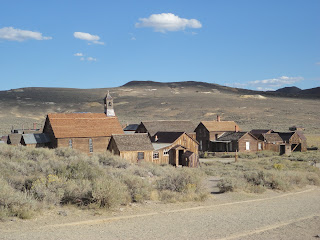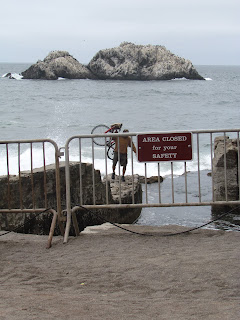Days 15 – 16

This morning began at the lovely Bodie Hotel in Bridgeport, California. Of course I am being facetious when I say
“lovely.” I guess if you were the type of person who found the Bodie to be
lovely you would also be the kind of person who would find Purgatory a great
place to vacation. I could go on and on, suffice to say I would rather forget
about the place.
 |
| 1949 Packard camping trailer? Goldfield, Nevada |
After leaving Bridgeport we headed south and made our way
back into Nevada. Traveling along the lonely desert highways we made our way
through the scattered old mining towns that dot the landscape in this part of
the country. These are hardscrabble towns where the people endured the heat and
a most foreboding landscape in order to make a meager living in the mines. Back
in the days of yore a man in old mining camps such as Tonopah and Goldfield
could work up mighty thirst. But these
old miners could drink with a clear conscience as they could use their beer
bottles to achieve the American dream – building their own home. Beer bottle
houses are found in a number of towns in west-central Nevada. Goldfield seems
to have the most. Rock was hard to quarry and local lumber was non-existent.
Beer bottles, on the other hand, were everywhere. While Goldfield seemed to
have the highest number of bottle houses, none of them compare to the greatest bottle
house located in the old ghost town of Rhyolite. Built in 1905 by a saloon
keeper named Tom Kelly, it is unique due to the fact that the bottles were not
covered with stucco. I first heard about the bottle house in Rhyolite when I
watched an old Charles Kuralt On The Road
segment when he visited the house in the early 1970s. When he visited the town
was populated by Rhoylite’s last resident, an old song-and-dance man and former
snake oil salesman named Tommy Thompson. Tommy Thompson came to Rhyolite in
1905 and was still there in the early 1970s filling the ruins of the town with
his personality. Interestingly enough Rhoylite was founded by Charles Schwab
who was baptized in Williamsburg in 1862 (fifth baptism according to our parish
records). In the segment Tommy Thompson
plays the accordion and speaks about the early days of this forlorn gold camp.

Having seen the Kuralt segment I had high hopes for Rhyolite.
Some of them were fulfilled, others were not. Gladly the house has been restored
(thankfully) and a fence was erected around the property. The house has
survived heat, wind (the wind howls through the mountains that surround the
ghost town), and atomic blasts (it is only about 50 miles from a nuclear
testing area), the house survives as a testimony to good construction and quenched
thirsts.
 After leaving Rholyte were not far from the fabled Area 51.
Perhaps visitors from other planets stop here to gas up and get a fountain drink.
After leaving Rholyte were not far from the fabled Area 51.
Perhaps visitors from other planets stop here to gas up and get a fountain drink.
Finally we made our way to fabulous Las Vegas. There are
many things I find troubling about Vegas; from my vantage point at the buffet I
think one could see all 7 of the deadly sins, gluttony being foremost. One man
cut in front of at the buffet on his scooter with a plate so full (a half eaten
corndog on top) that he had no room for the egg rolls he had picked up so he
placed them in the pocket of his jacket. While the buffet at the Rio hotel was
great, it reminded about excess and need.
 After supper I traveled to the famed Gold and Silver Pawn
Shop, home of the television show Pawn
Stars. Sadly Chumley has not there. The store is not as big as you would
think, but it was worth the visit.
After supper I traveled to the famed Gold and Silver Pawn
Shop, home of the television show Pawn
Stars. Sadly Chumley has not there. The store is not as big as you would
think, but it was worth the visit.
An older Rich Little and Fr. Aron
After the pawn shop Fr. Doug got two rooms at the Rio hotel.
I originally wanted to just stay up all night and go to the airport early in
the morning. Fr. Doug wanted to rest (rest is overrated) and got two rooms for
$39.00 each. For the price you could not get a better deal. After a brief rest
we headed to the Las Vegas Hotel to see Rich Little. Now to people of a certain
age the name Rich Little is very familiar. Others may ask, “Rich Little, is he
still alive?” Still others ask, “who is Rich Little.” Rich Little was the preeminent
American mimic in the 1960s and 1970s. He is a regular on the old Dean Martin Celebrity Roasts. He and Don
Rickles are basically the last two comedians of that generation who are still performing.
For the show Rich narrates Jimmy Stewart’s life as Jimmy Stewart (one of his
famous impersonations) and does over thirty other impressions of people talking
about Jimmy Stewart. If you are an old soul like me, or if you are just plain
old, you would love this show. These old stars live on in Rich Little, a man
who actually knew all of them. A cavalcade of old time characters came to life.
The best impressions in my opinion were
Walter Brennan, Paul Lynde, Foster Brooks, and Johnny Carson. He even did Karnack
the Magnificent. When he was impersonating Don Rickles he ripped on Fr. Doug
(we were in the front row) and told him that he hoped that when he jumped on
his bicycle the seat would be missing. In the end I shook his hand and second
only to seeing the Pope it was my second best encounter with greatness.
After an early start, 4:30 AM, we boarded our plane and
after two stops landed in Pittsburgh. Centuries ago Marco Polo once reported “I
have not told half of what I saw.” I concur. Thanks for reading.








































